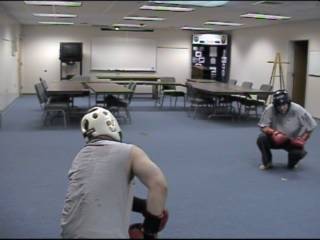I've always looked at martial arts, in general, as an equalizer, much like the Colt 45 in the old west. I believe that you can improve your chances of survival in all self-defense situations if you have
some training. For that training to be effective, though, you have to train
as if you're in the situation.
This brings to mind something saw last winter at the skating rink near our home. As we were waiting for one of our kids' lessons to begin, I watched as the figure skaters were warming up in the main lobby area. Some of the competitors were just stretching and moving around, but a couple of them were practicing their jumps and spins in the air, then landing on the floor in tennis shoes. I realized that they were not only practicing some of the mechanics of the technique or jump, but from the focus, they were visualizing being on the ice.
That's how we should utilize the components of our training - everything can, and should, have a practical component. How often will we use a technique? Hopefully, never. If we need to, I don't think it's as important as being prepared to use
whatever we have ready. By this, I mean that if I have very heavy boots, restrictive clothing such as jeans and a winter coat on, I probably won't be kicking very high, if at all. But, I should have full use of my hands, and can count on some protection from my clothing as well. If you've ever worn bag gloves, you can attest to the fact that you can hit a lot harder with them on than with them off.
What's more important than what I wear is that I have mental preparation and confidence that I can avoid or handle something. So how can we prepare?
Train with self-defense in mindDrill scenarios like being attacked as you get in or out of your car; pushed from behind; grabbed from behind; tackled and pinned; in very light or dark conditions.
Train outdoors in street clothes. Make your training environment more realistic.
Train in confined spaces. Use a parking lot, or simulate an elevator or office area.
Mentally rehearse. Inconspicuously look someone over so that you could identify them. Go from head to toe: height, build, skin color, facial hair or other distinguishing characteristics, clothing, footwear. Could he have a weapon? Think about what you would do versus an initial move or attack by that person.
Think of escape routes. Never a good idea to turn your back, but, can you get away without being exposed to potential danger?
Practice the dynamics of fighting, not sparring. There is a very big difference between fighting and sparring. As you may know, sparring can be pretty, rythmic, clean (technique-wise), and can take a while. Sometimes in sparring, you need to pace yourself. Fighting is all-out, vicious, and messy. It doesn't have a discernable rythme, and there is no referee, or clock, so you don't have rules, and sometimes pacing yourself is going to mean you give your opponent more chances...
Train to survive fighting more than one person. Try to spar, at first, with more than one person until you get pretty competent at it. Then try to fight against a pair of partners that are working together to try to tackle or pin you. If you're really brave, try this against 3.
Train to defend and survive an armed attacker(s). Practice
knowing where you are - don't get lost, and pay attention!
Use your environment to survive.

